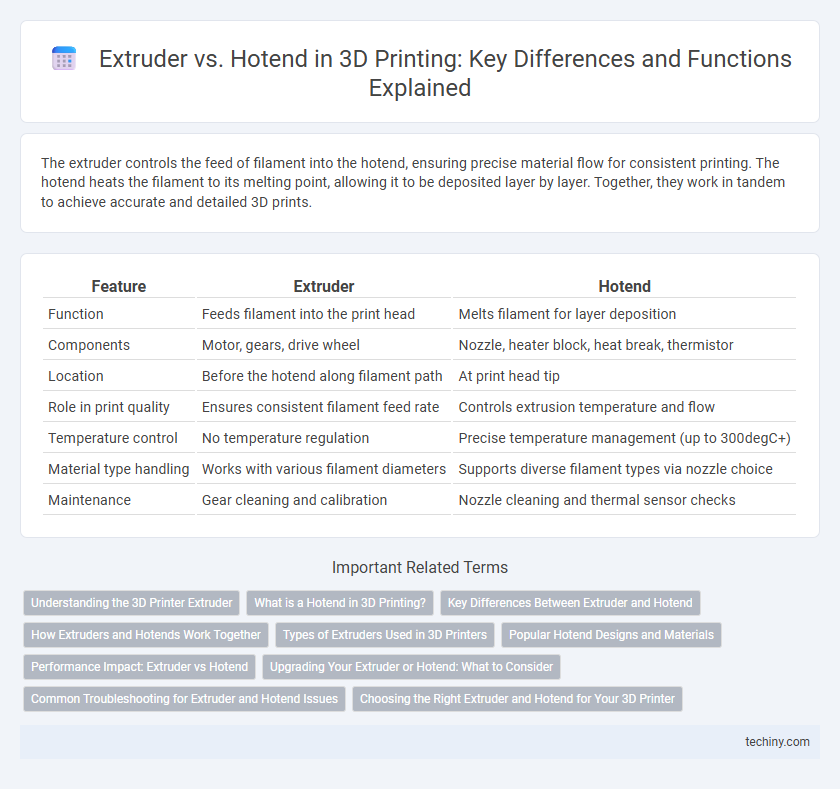The extruder controls the feed of filament into the hotend, ensuring precise material flow for consistent printing. The hotend heats the filament to its melting point, allowing it to be deposited layer by layer. Together, they work in tandem to achieve accurate and detailed 3D prints.
Table of Comparison
| Feature | Extruder | Hotend |
|---|---|---|
| Function | Feeds filament into the print head | Melts filament for layer deposition |
| Components | Motor, gears, drive wheel | Nozzle, heater block, heat break, thermistor |
| Location | Before the hotend along filament path | At print head tip |
| Role in print quality | Ensures consistent filament feed rate | Controls extrusion temperature and flow |
| Temperature control | No temperature regulation | Precise temperature management (up to 300degC+) |
| Material type handling | Works with various filament diameters | Supports diverse filament types via nozzle choice |
| Maintenance | Gear cleaning and calibration | Nozzle cleaning and thermal sensor checks |
Understanding the 3D Printer Extruder
The 3D printer extruder is the key component responsible for feeding filament into the hotend with precise control, ensuring consistent material flow during printing. Unlike the hotend, which melts the filament, the extruder consists of gears and a stepper motor that drive the filament forward at regulated speeds to maintain print accuracy. Understanding the distinction between the extruder and hotend is crucial for optimizing print quality and troubleshooting extrusion-related issues in FDM 3D printers.
What is a Hotend in 3D Printing?
A hotend in 3D printing is the component responsible for melting and extruding filament through a nozzle to create precise layers in the printed object. It consists of a heating block, nozzle, heat break, and a heater cartridge or thermistor to regulate temperature accurately. The hotend works in conjunction with the extruder, which feeds the filament into the hotend, ensuring consistent flow and quality during the printing process.
Key Differences Between Extruder and Hotend
The extruder controls the filament feed mechanism, pushing the material towards the hotend, which heats and melts the filament for deposition. The hotend operates at high temperatures to liquefy the filament, enabling precise 3D model layering, while the extruder maintains consistent filament flow and tension. Understanding the distinct roles of the extruder's mechanical drive and the hotend's thermal processing is crucial for optimizing print quality and troubleshooting extrusion issues.
How Extruders and Hotends Work Together
Extruders and hotends are essential components that work together to achieve precise 3D printing by controlling filament flow and melting. The extruder drives the filament towards the hotend, where the material is heated to a specific temperature for extrusion through the nozzle. This synchronized operation ensures accurate layer deposition, influencing print quality and surface finish.
Types of Extruders Used in 3D Printers
Direct drive extruders, Bowden extruders, and geared extruders are the main types used in 3D printing, each offering distinct advantages in filament control and precision. Direct drive extruders position the motor close to the hotend, providing better retraction and flexible filament compatibility, while Bowden extruders reduce moving mass by separating the motor from the hotend using a PTFE tube. Geared extruders incorporate internal gears to increase torque, enabling consistent feeding of flexible or abrasive filaments for improved print quality.
Popular Hotend Designs and Materials
Popular hotend designs in 3D printing include all-metal and PTFE-lined variants, with materials such as stainless steel, brass, and aluminum commonly used for heat blocks and nozzles. All-metal hotends, favored for high-temperature printing, often feature hardened steel or tungsten nozzles to resist abrasion with abrasive filaments. PTFE-lined hotends offer smoother filament flow for lower temperature applications but require periodic replacement due to thermal degradation.
Performance Impact: Extruder vs Hotend
Extruder performance directly influences filament feed consistency and torque, impacting print precision and speed, while hotend temperature stability and heat distribution critically affect layer adhesion and print quality. A well-calibrated extruder paired with an efficient hotend reduces issues like filament jams and under-extrusion, enhancing overall print reliability. Optimizing both components ensures smoother filament flow, improved dimensional accuracy, and higher-quality 3D printed parts.
Upgrading Your Extruder or Hotend: What to Consider
Upgrading your extruder or hotend requires evaluating compatibility with your 3D printer model, filament types, and desired print resolution. Consider factors such as extrusion force, temperature range, and material durability to optimize print quality and minimize maintenance. Ensuring your upgrade supports advanced filaments like TPU or polycarbonate enhances versatility and long-term performance.
Common Troubleshooting for Extruder and Hotend Issues
Common troubleshooting for extruder issues includes checking for filament jams, ensuring the drive gear is clean and properly tensioned, and verifying that the extruder motor is functioning correctly. Hotend problems often involve clogged nozzles, incorrect temperature settings, and thermal runaway errors, which require careful inspection of the heating element and thermistor connections. Regular maintenance and calibration of both the extruder and hotend components are essential to prevent print failures and maintain consistent extrusion quality.
Choosing the Right Extruder and Hotend for Your 3D Printer
Selecting the ideal extruder and hotend for your 3D printer hinges on factors like filament type, printing speed, and desired precision. Direct drive extruders offer superior control for flexible filaments, while Bowden setups reduce weight for faster print speeds. Matching a high-quality all-metal hotend with an efficient extruder ensures optimal temperature stability and filament flow, enhancing overall print quality and reducing clogs.
Extruder vs Hotend Infographic

 techiny.com
techiny.com